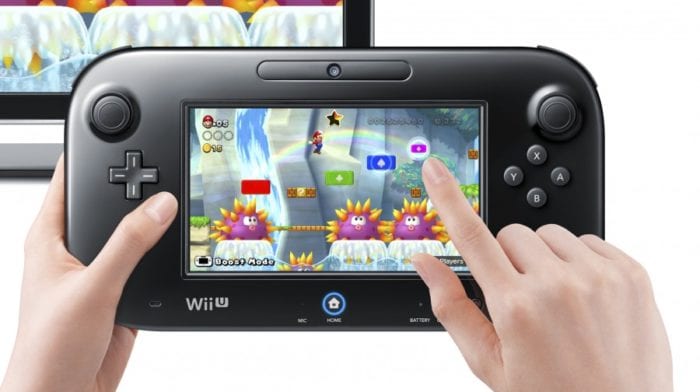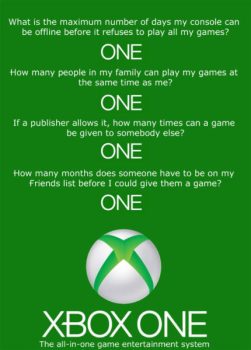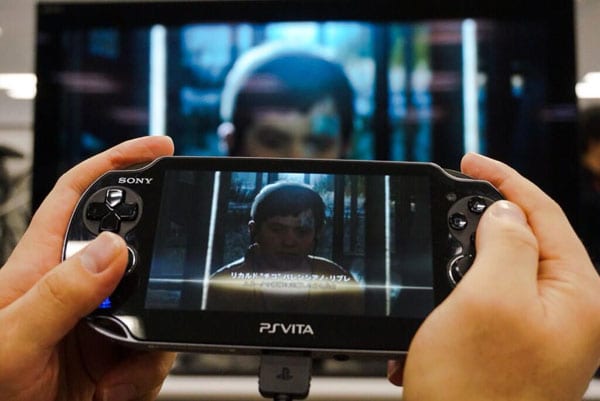There’s a famous proverb that says, “luck is what happens when preparation meets opportunity.”
It’s attributed to some dude named Seneca, who, if I recall correctly, was the backup quarterback for the Seattle Seahawks in the mid- to late-2000s. Apparently quite the scholar.
The reason I refer to this phrase is because I confess with all transparency: I am writing this article solely with the intention of starting my year with a pun. Calendar-based puns are particularly special, you see, because they rely entirely on timeliness. I legitimately hate myself every April 30th when I forget to share the Justin Timberlake ‘it’s gonna be May’ meme, an agony that stretches on for an entire year.
So yes, friends, I am constructing a piece about hindsight in the gaming industry, specifically and exquisitely, so that I can proclaim that I am using 2020 vision. If the rest of the article sucks, I’m not even sorry. It was that worth it.
Seneca would be proud of my patience.
The Wii U

Nintendo has been around the block so many times, the ground itself is beginning to show track marks reminiscent of Scrooge McDuck’s worry room. As such, they’re bound to have a literal embarrassment of misfires and pratfalls that they’d rather leave far, far behind them.
More often than not, however, they then apply masterstrokes, such as the humble Robotic Operating Buddy that practically saved the flagging industry in the mid-80s. So yes, we forgive them their trespasses, by and large.
The Virtual Boy was Nintendo’s silliest botch to date; a cumbersome, cruel piece of technology that didn’t really appeal to anyone. But the stakes were fairly low at the time, so its negative impact is somewhat muted. It was rushed to the market to make way for the upcoming Nintendo 64, and the continued success of the Super Nintendo and Game Boy cushioned the collapse of the shambolic red beast.
However, their biggest failure outright, clearly, remains the Wii U. Nintendo was riding on the high of the mighty Wii, a console that thrived on enticing non-gamers to pick up its intuitive remote and give it a try. Whether they ever played anything beyond the bowling game from pack-in title Wii Sports is largely inconsequential: Nintendo had done something rare, and transcended the industry to reach the masses.
The reasons why Reggie Fils-Aime’s E3 2011 presentation unveiling the Wii U went awry have been widely discussed throughout the years (our own Ed McGlone took it to task in his list of abysmal E3 announcements). The basic gist is that little was done to distinguish the Wii U as being a successor to the Wii, as opposed to a new accessory.

An unclear message is dangerous enough in this — or any — industry, but when you consider how many gaming novices were newfound Nintendo fanatics, they were practically playing with fire. The intention, no doubt, was to ride the wave of the Wii’s brand recognition, integrating existing peripherals like the Wii remote to make a smooth transition into the next stage.
But people didn’t understand, and Nintendo didn’t do enough to elucidate them. When consumers are presented with technology that confuses them, they feel estranged and bothered. Cast your mind back to the advent of the Super Nintendo, initially met with skepticism because parents couldn’t fathom why they couldn’t play these new games on their existing Nintendo console.
…Seriously, watch the video. Kent Shocknek playing F-Zero is the best thing you’ll see all week, and I earnestly hope he’ll be an unlockable character in a future release.
To say that this doomed the Wii U would be revisionist history. Initial sales of the console were not excruciatingly bad, but what followed saw Nintendo drift further and further away from critical third-party support. They were zigging where the industry was zagging, and though this usually bore fruit for them in the past, putting them ahead of their competitors, this time they had completely misjudged the desires of the market.
Gamers wanted stronger consoles with solid online capabilities, and the Wii U was trailing far behind in both aspects. Poor sales of multi-platform titles spooked developers away, and before long, Nintendo was practically keeping the system on life support with the quality of their own software. Reading this 2014 Eurogamer piece by a developer who had worked with the Wii U from the start is almost chilling, because it shows how a few critical decisions could sink the whole ship.
“…a basic comparison/calculation makes the Wii U look, on paper at least, significantly slower than an Xbox 360 in terms of raw CPU,” the anonymous developer reveals. “This point was raised in the meeting, but the Nintendo representatives dismissed it saying that the “low power consumption was more important to the overall design goals” and that “other CPU features would improve the performance over the raw numbers.”
The frustrating thing is that the Wii U, when utilized appropriately, is a lot of fun. Yes, the Gamepad can prove unwieldy when compared to a conventional controller, but the enticing potential shown off in launch title Nintendo Land gave a glimpse into how things should have been.
I legitimately love Mario Chase, don’t you?

Trying to determine how to save the Wii U, however, is like trying to course correct Nintendo itself. The GameCube was a console that treaded water because it didn’t really do much that its competitors couldn’t, while the Wii strived to be unlike anything else. Its follow-up absolutely couldn’t return to the status quo, but the application didn’t meet the ambition. No games means no sales, and no sales means no smiles.
Perhaps it’s because of the lessons learned, fundamentally and technologically, that Nintendo could strike gold with the Switch a generation later. The Wii U crawled so that it could walk, or some form of similar analogy.
When it comes down to it, this plucky little console may have been just as condemned to failure as the Virtual Boy.
The Xbox One

Success is relative, of course, and to compare the shortcomings of the Xbox One to the Wii U is apples to oranges. However, in every console generation, Microsoft has remained the bridesmaid, never the bride — or Chick Hicks from Cars, if you’d prefer. He is appropriately green, after all.
The Xbox One in its various iterations has sold somewhere around 45 to 46 million units in its lifespan, good for 15th all-time among consoles. That sounds pretty sweet in a vacuum, but a quick look at the charts tells a different story. Sony storms towards the next console generation like an unstoppable juggernaut, having cleared 100 million PS4s sold, while the Nintendo Switch, released roughly three and a half years after the Xbox One, might have already claimed second place as of last month, by some estimates.
Even the Xbox 360 puts the current edition to shame, with almost 86 million units sold. In a short span of time, Microsoft went from Sony’s rival to Sony’s lesser cousin, and that’s not a situation anyone wants to be in.
Microsoft was positioned perfectly to wrest a significant market share from Sony after the success of the 360. Indeed, the primary reason Microsoft came third in that generation comes down to its inability to crack the Japanese market, a truth that has faced the Seattle-based company dating back to the original Xbox.
To the rest of the world, Microsoft was a contender. So they went into the Xbox One with all guns blazing. And funnily enough, there were more parallels to the Wii U’s issues than you might think.

Confusing branding was at the forefront once again. The One moniker, Don Mattrick told us upon its reveal, was intended to represent this console as an ‘all-in-one’ home entertainment system, but for many, it sounded like a step back. Wasn’t the first Xbox the Xbox One? How had we gone from a full 360 revolution down to a single digit? Where’d the other 359 go, Microsoft?
I don’t care where you put them… give them back!!
In all seriousness, damage control over something so straightforward as a console’s name is a hurdle that can be easily avoided, but the more concerning thing is that Microsoft seemed intent less on dissuading concerns, and more on telling us that we were simply in the wrong.
Per a 2013 CNET interview with Jeff Henshaw, “the thing you have to bear in mind, is that if you look at the original Xbox, the experiences have grown to become so dramatically rich and different. There’s no resemblance anymore between the two. You can’t confuse them in any way. So when people say “Xbox One,” it’s going to be reflective of this new generation of experiences. I really don’t think there’s going to be any confusion.”
This rhetoric was consistent, and read off like a laundry list of obtuse ideas that should have never gotten past the brainstorming stage. Playing a game, even one that had no online features, required a daily connection to Microsoft’s servers. The Kinect accessory was mandatory to use the console, and remained operating at all times. Physical games would be tied to your Xbox Live account, rendering trade-ins and lending discs between friends impossible.

Sony famously slam dunked that last notion in its second most amazing burn of all time. It trails only Steve Race’s legendary E3 ’95 declaration of “299”, the moment that crushed the Sega Saturn.
Step for step, every questionable thing that Microsoft announced, Sony was quick to distance its own console from. The Xbox One was designed to be a very specific thing for a very specific type of gamer, to the exclusion of everyone else, and it set the console behind the 8-ball from the get-go. Most of these ideas, of course, were hastily scrapped.
What has since plagued the console has been a lingering question of why you would buy the Xbox One instead of the PlayStation 4, and on the software front, there aren’t a lot of pluses. Each has a robust library, but once you remove multiplatform titles, the Xbox One is left comparatively threadbare. Sony’s exclusives include console shifters and game of the year contenders, while Microsoft’s offerings have been much less enticing, and in many cases, overwhelmingly disappointing.
It seems apparent that the Xbox One’s greatest crime is that it focused too greatly on what it could do, rather than what it should do, prioritizing its technological vision over its games. There have been some highlights, such as Cuphead, Gears 5, Forza Motorsport 7, or Sea of Thieves (which as you may recall, took some time to get going after a sluggish start).
Again, to deem the console a ‘failure’ depends on your definition, and the Xbox One can only be considered one when you pit it against the skyrocketing numbers of the PS4. There are triumphs, too — Microsoft’s Game Pass has long been considered superior to PlayStation Now, typically offering newer games, and the ability to cross-save between PC and Xbox One is an underrated function that opens up versatility that the other consoles lack.
Looking ahead, the pieces are in place to regain ground, as Microsoft has been acquiring studios en masse, loading up on ammunition to bolster their library and offer the major exclusives they so sorely need.
“We are shifting from growth and acquisitions to execution and delivery,” declared Xbox Game Studios head Matt Booty.
For this generation however, it’s too little, too late. The Xbox One can delight with a magic trick on occasion, but across the road, Sony has got an entire show that dazzles routinely. It also has tigers.
The PlayStation Vita

If you thought Sony was going to be let off the hook, you may have forgotten about this little gem. Funnily enough, I forgot as well, and was about four paragraphs into a retrospective on SEGA’s death as a hardware manufacturer to close out this article.
But the Vita is Sony’s biggest blemish on an otherwise pristine record, and the fact that it’s so easily disregarded is a testament to exactly how it failed to deliver.
The PlayStation Portable was quite the hardware sales juggernaut, moving over 81 million units in its lifetime, good for 10th overall in console history. It doesn’t get as much recognition for a couple of reasons; chiefly, because its direct competitor, the Nintendo DS, went on to become the bestselling handheld console of all time at almost 155 units, trailing only the Sony’s PS2 for the highest ever.
A deeper dive also reveals that those hardware sales ought to be taken with a grain of salt, as the PSP had a fairly poor tie-ratio. In other words, the amount of games sold compared to systems sold was low, especially when measured against the impressive tie-ratios of Sony’s home consoles. By today’s standards, it’s something of an outdated metric, and Nintendo has begun to shift away from it, but it’s still an interesting tidbit.
Digression aside, the PlayStation Vita, like the other consoles we’ve covered so far, had the chance to make its impact in a previously prohibitive market. Nintendo’s strength in the handheld arena was perhaps its most impenetrable wall, a fact that has been proven generation after generation, but here we had an industry giant that looked to do the unthinkable with its second attempt.

As was true in the DS vs PSP debate, Sony clearly had the stronger hardware in the Vita, and as you may recall, the 3DS got off to an absolutely dreadful start. Nintendo had to pivot boldly from optimistic to apologetic, slashing the price within the first six months and appeasing early adopters with free virtual console games.
Never before had Nintendo appeared so vulnerable, and this was Sony’s opportunity to go for the jugular and bury their rivals once and for all. When the Vita launched a few months later however, it had its own concerns to deal with.
It launched at a cost of $250 USD — reasonable considering the advanced tech, albeit the exact same figure that Nintendo had so hastily reduced to $170 — and sold a little over 1.2 million global units in its first week, fewer than the PSP, the DS, or the 3DS had managed.
Sony remained stubborn on this front despite missing their sale projections in the handheld’s first year, and it wasn’t until August 2013 they announced their own price cut in North America, reduced to an RRP of $199.
By this time, the 3DS had pulled up from its tailspin with a string of solid titles, and offered more bang for less buck. To help twist the knife, Nintendo then released the 2DS that October at a price point of $130 USD.
Combined with consumers’ distaste for its expensive, mandatory memory cards and a lack of killer apps, the Vita was in trouble, and needed a serious kickstart to bring it back into contention. It had all the framework in place; as The Verge’s Sam Byford so boldly put it, “the PS Vita is the best handheld console ever made; it’s just had the misfortune to arrive at a time when no-one — not developers, not consumers — seems to want one.”
What happened next was nothing short of miraculous, as Sony effectively walked away from its floundering handheld with a shrug of indifference, and turned their efforts towards the PlayStation 4. In much the same way the Virtual Boy was left for dead to make way for the Nintendo 64, the Vita was left to its own devices, with incoming software quickly reducing to little more than a yearly trickle. By 2015, they had stopped producing first-party titles altogether.

For the next few years, the PlayStation Vita was kept afloat by indie titles and continued support in Japan, until they finally pulled the plug last year.
Perhaps wisely, Sony stopped releasing individual platform sales in 2013, masking the Vita’s tepid numbers as the company prepared to shuffle it off into an early grave. Its estimated sales figures put it somewhere in the realm of 10-15 million, unenviable territory shared by such luminaries as the SEGA Game Gear or the Wii U. The 3DS, meanwhile, has eclipsed 75 million units as it settles into retirement.
Sony’s reluctance to stick with the Vita during its hardship was its greatest undoing, and a stark contrast to what Nintendo chose at the same juncture. Considering the raging success of the PS4, it’s not of any particular concern to Sony, but for those passionate few who so wanted to see it succeed, it evokes quite the feeling of abandonment.
I think Ed said it best last year when things were winding down, “the PS Vita has survived this long in spite of Sony, not because of them.”













Updated: Jan 2, 2020 10:01 am